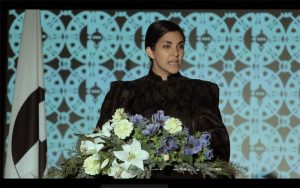Fabiola by Francis Alÿs at the National Portrait Gallery in London. I know i say this several times a year but i mean it each time: this is the best artwork i’ve seen in a long time.
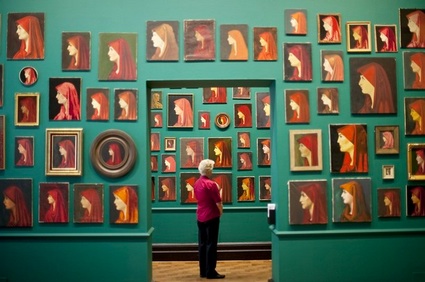 Francis Alys, “Fabiola,” at the National Portrait Gallery (BEN STANSALL/AFP/Getty Images)
Francis Alys, “Fabiola,” at the National Portrait Gallery (BEN STANSALL/AFP/Getty Images)
Fabiola can be summed up in a few words: it consists in a collection of 300 profile of the same woman, hung side by side inside two deep green rooms.
The woman at the center of the exhibition is Saint Fabiola, a 4th century woman married to a man so immoral and abusive she asked for divorce. Upon the death of her second husband, she entered upon a life of renunciation which she led until her death in 399 or 400. Not only did she devote her immense wealth to the needs of the poor and the sick, she also erected a hospital at Rome, and waited on the inmates herself. She also gave copious amounts of money to the church which was a sure shortcut to beatification.
Jean-Jacques Henner painted an idealized profile of Fabiola in 1885, but the painting was lost in 1912. The image was copied by hundreds of artists around the globe over the last century. The popularity of Fabiola is probably due to the fact that she is the patron saint of difficult marriages, abuse victims and nurses. Francis Alys toured the flea-markets, private collections and junk stores to buy as many amateur reproductions of Henner’s painting as he could get his hands on.
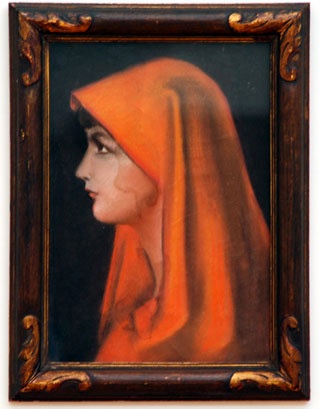 M. M., Fabiola, n.d. Photo: Francesca Esmay.
M. M., Fabiola, n.d. Photo: Francesca Esmay.
Courtesy Francis Alÿ
How can 300 cheapo copies of the same profile of a fourth century Christian saint originally painted by an artist most of us have never heard about be interesting? I don’t really know the answer to that but i know that the magic is there. Seen from afar, the effect of these paintings is stunning. Seen from up close, the portraits are equally fascinating. It’s the same face over and over again, the same woman wearing the same clothing and looking to the right most of the time. You go from one to the others and marvel at the subtle and not so subtle differences between them. It’s not just the shade of her red veil, it’s her tiny or crooked nose, her matronly or youthful air, the soft Bambi-like eye or the stern look she gives, sometimes the portrait is on velvet, another one is made of vanished seeds and one is embroidered.
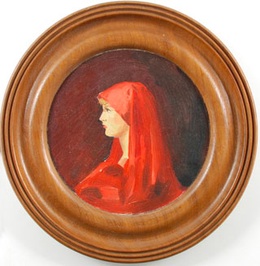 Unknown artist, Fabiola, n.d. Photo: Francesca Esmay. Courtesy Francis Alÿs
Unknown artist, Fabiola, n.d. Photo: Francesca Esmay. Courtesy Francis Alÿs
Many of the paintings are pretty bad and that’s what makes the show all the more fascinating. Who would have thought that a work in which quantity prevails over quality could be so spectacularly enthralling? I’ve used the word “artwork” perhaps inappropriately. Fabiola feels like artwork by Alÿs rather than an exhibition of a collection made of over 300 artworks that he has spent 15 years gathering. But i suspect many would disagree with me.
As Lynne Cooke wrote in her essay about Fabiola: In the eyes of its creator and owner, artist Francis Alÿs, this collection invites investigation as a collection, in and of itself. Although he has developed a conceptually based practice, Alÿs plays down the claim that the acquisition and presentation of his collection constitute a work in his own oeuvre. Instead, he emphasizes the process, the way in which the open-ended activity of amassing and shaping his collection has devolved into a mode of inquiry or investigation.
Alÿs is still collecting Fabiolas and adding the new ones to each stop of his touring exhibition (it was shown at LACMA and at the Hispanic Society in New York.)
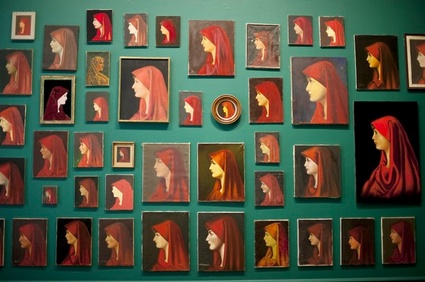 More images + video and audio comments on the exhibition.
More images + video and audio comments on the exhibition.
Francis Alÿs: Fabiola is on view at the National Portrait Gallery in London until September 20, 2009.




